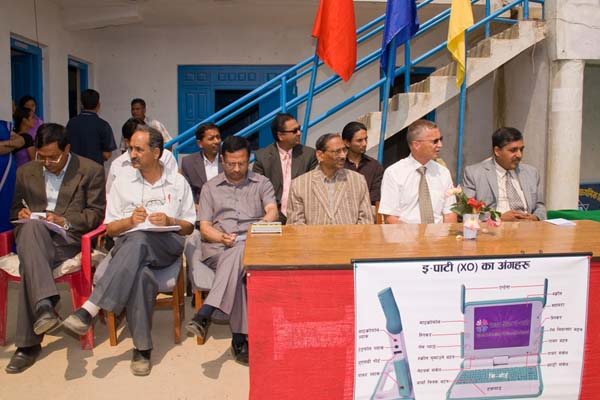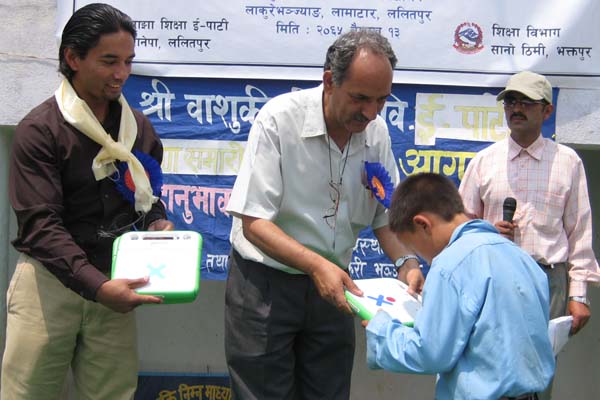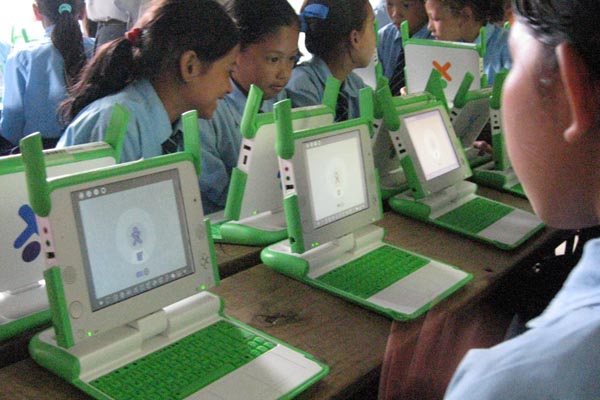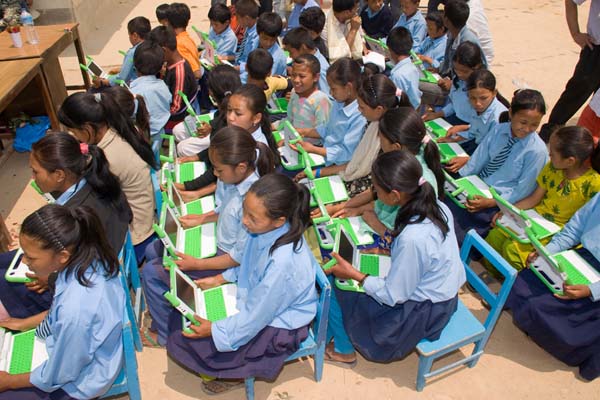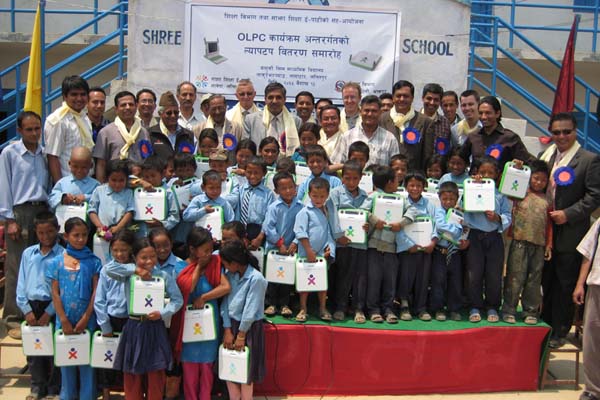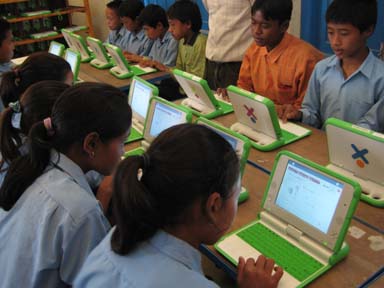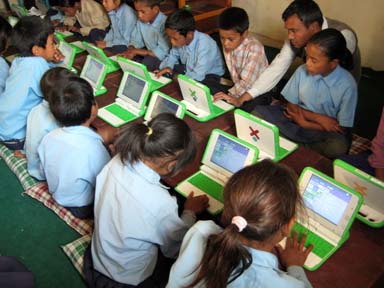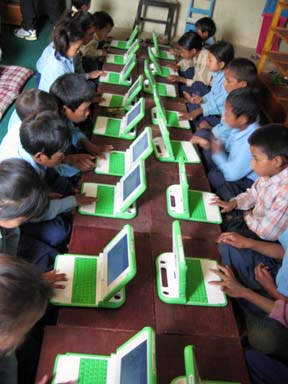OLE Nepal: Blog Announcements
← Blog Home · Development→
Announcements
Second OLPC Game Jam
Second OLPC Game Jam
January 30th, 2008 By: Om Yadav
We are going to hold our second ‘OLPC Game Jam’ on 9th February 2008. We are expecting to see quite a few participants from our first jam and new participants too. Please spread the word and sign up on our discussion forum to participate in the discussion and share your ideas.
ACE Institute of Management has generously provided us their computer lab for the event. Special thanks to Ms Prabina Rajbhandari, Mr Jayanta Pokharel, Ms Nirvika Prakash and Mr Bishnu Dhakal for their help and support.
We have a limited number of seats and want to make sure that every participant gets their own machine to develop their activity. If you are interested in participating reserve a seat by sending an email to register@olenepal.org.
We're Looking for a Super SysAdmin
We’re Looking for a Super SysAdmin
March 4th, 2008 By: Sulochan Acharya
The Problem
Over the course of 2008, OLE Nepal will implement OLPC at a number of schools in Nepal. Some important technical aspects of deployment are the updating the XO’s, back up of student data, maintaining mesh network, and web caching. Much work remains to be done in the general area of the School Server. The School Server is currently under active development and will likely be so throughout 2008. OLPC recently made a great decision in hiring Martin Langhoff to serve as the School Server Architect. Here in Nepal, we need a rockin’ sysadmin that can work with our Kathmandu-based team and with OLPC to implement a school server solution that meets the needs of kids and teachers in Nepal.
We need this person to can commit 5 months full-time here in Nepal. You need to be local because working remotely won’t expose you to the real requirements of schools in Nepal. This is a volunteer position. We operate on a shoestring and volunteers already do a good portion of our organization’s work.
Your Skills
You dream in Bash IPv4, IPv6, Wireless Mesh networking? No problem! You know linux networking inside and out Extensive knowledge of BIND, DHCPD, Squid, Apache, security, etc. Experience working with Moodle would be most excellent Adept with Python scripting or could learn it quickly. OLPC has standardized on Python for scripting You look to implement a practical solution that less skilled sysadmins can easily maintain over a cooler but more complicated solution. You play well with others. You don’t alienate collaborators with rude e-mails that assert your technical superiority (even though you are) Your primary concern is meeting the educational needs of kids and teachers. Your rate technical awesomeness a distant second to meeting those critical needs.
What you Would Do
Work with our deployment team to set up and maintain School Servers, customized XO builds, and the Active Antenna Collaborate closely with Martin Langhoff and John Watlington of OLPC to enhance the mainline School Server distribution, move our local additions into the main distribution, and communicate Nepal’s requirements to OLPC Over the course of your stay, work to make the School Server as stable and easy to maintain as possible Document our configurations for our own reference and the use of other OLPC deployments Your immediate colleagues would be
Dev “Where’s the Party Yaar?” Mohanty, in charge of connecting the schools to the Internet
Sulochan Acharya (me), general troubleshooting of all technical problems at the schools
Bryan Berry, leads the deployment team, does planning, budgeting, and basic system administration among other duties
Who Should Not Apply
If you are looking for a vacation in an exotic locale, go to Thailand. We work hard, very hard. We have a lot of fun too.
You are only interested in OLPC’s technology and have little interest in its educational goals. As Nicholas Negroponte frequently repeats, this is an education project not a laptop project. If you are not genuinely interested in meeting the needs of kids and teachers, please do not apply. This is worth repeating. If you are not genuinely interested in meeting the needs of kids and teachers, please do not apply.
You are not able to commit to a 5-month stay in Nepal.
What we can offer you
A fantastic opportunity to work on a really important project. A chance to radically enhance the quality of education in Nepal. A contribution to a larger global initiative. I could go on forever . . .
Now, we would love to pay you but as mentioned earlier our operation runs on a financial shoestring. This is a volunteer position. We can put you up in the OLE Nepal house together with Ties, Dev, and Dev’s lovely lady friend Manisha. Living costs in Nepal are __quite__ low. You can consult our current volunteers Ties, Dev, and Bryan about their expenses.
The Outcome
You walk away from Nepal having implemented a turn-key school server solution that helps kids and teachers collaborate, discover important ideas, and create things that matter to them. Your work will be replicated across OLPC deployments.
If you are interested please send an e-mail to info@olenepal.org.
Laptop project formally launched
Laptop project formally launched
April 28th, 2008 By: Rabi Karmacharya
On April 25, 2008, Open Learning Exchange Nepal (OLE Nepal) distributed a total of 135 OLPC laptops to grade 2 and 6 students from two schools in the outskirts of Kathmandu Valley. These were addition to the 22 laptops that were handed out to teachers from the schools during the teacher preparation program held a month ago. The laptop project was undertaken in partnership with Nepal government’s Department of Education (DoE). This project is part of OLE Nepal’s mission to increase quality of education while reducing current disparity in access and quality between school types, regions, and population groups by integrating ICT-based education in daily teaching-learning process. The laptops for the project were donated by the Danish IT Society in Copenhagen.
The distribution program started in the morning at Bashuki Lower Secondary School in Lakuribhanjyang, Lamatar VDC in Lalitpur district. As guests made their way up the dusty gravel road leading up to the school, students, teachers, parents, and community members waited anxiously for the program to begin. OLE Nepal team was there ahead of others with the laptops, and was busy helping with the program setup. Guests were given a short tour of the school that highlighted the internal wireless network, the wireless radio network that connected the school to the DoE and OLE Nepal office, the power arrangements including the power racks, the school server, and the classrooms where seating was arranged to encourage interaction.
The Chief Guest of the program was the Secretary of Ministry of Education and Sports Mr. Balananda Poudel. The secretary is the highest level civil servant in the ministry. Other special guests included Executive Director of Curriculum Development Center Mr. Haribol Khanal, Executive Director of National Center for Education Development Mr. Ram Swaroop Sinha, Director of DoE, Mr. Mahashram Sharma, Chief District Education Officer Mr. Babu Kaji Karki, Lalitpur Minister Counselor of the Danish Embassy Mr. Ove Larsen, Chairperson of the OLE Nepal Board of Directors Dr. Prativa Pandey. The program was widely covered by journalists from major media outlets including print and TV.
After the welcome speech and few words by the special guests, we proceeded to hand out laptops to the 75 lucky students. The kids were quite excited when they were handed the laptops. They immediately went back to their seats and opened the laptops, and with the help of OLE Nepal team members, they started checking out the activities that were in the laptops. While journalists, photographers, and cameramen were busy capturing the moment, the students were already showing off what they had discovered to their friends. It was quite interesting to see how they handled the laptops with care, and it was obvious that they greatly valued their newly received education tool.
After few photo ops we headed to the next school, Bishwamitra Ganesh Lower Secondary School in Jyamirkot, Lubhu VDC, Lalitpur. After a brief stop for lunch at the bottom of the hill, we arrived at our destination where the teachers offered us a warm welcome with garlands and flowers. At this school, we handed out 60 laptops to the students. The reactions from the students were similar to that of the Bashuki.
After the long and arduous day, we trudged back to our office in the evening with a great sense of accomplishment, but knowing too well that our real work had just begun. A lot of questions still loom in our minds. How will the children take care of the laptops? Will the network be able to handle the traffic when 70 children try to access the Internet together? Will the laptops have hardware problems? Will the teachers be able to successfully integrate the new teaching method in daily teaching? This is, after all, the test phase of the project, where OLE Nepal, along with the Department of Education hopes to find answers to the questions surrounding challenges in implementation. The plan is to use the findings to prepare a scalable model that can be replicated when we expand to schools in other districts.
The laptops have finally reached their destination. They have come a long way, and was made possible only through the contribution and hard work of many individuals and organizations. One Laptop Per Child has to be credited for defying the critics and coming up with this amazing piece of machine that we believe will transform education around the world. We owe our gratitude to the Danish IT Society for providing the laptops for Nepal’s test phase. We hope that with a successful implementation of this phase, we can expect similar support in the future phases. Special thanks go to Dr. Richard Rowe and his team at OLE Inc in Cambridge, USA, for the constant support and guidance, the Danish Embassy in Kathmandu for supporting the project, and Corelatus, Sweden, for providing the funds to network the schools. We would also like to thank Mr. John Cook and Mr. Peter Dalglish for their constant advice and support. We cannot end without mentioning that we have been blessed with a dynamic group of individuals that comprise our Board of Directors.
We have not cut any corner in our preparation building up to the deployment of the laptops. We put in a lot of effort in preparing the teachers in both schools, including the 4 day residential training program. We have paid close attention to each of the learning activities we have built. Our team put in endless hours preparing the laptops. We have spent a great deal of time setting up the wireless network. We built special power racks to charge the laptops with ease. We designed sturdy bags that have compartments for the laptops. But, we all know that there will always be unforeseen problems and challenges. With the dedication of our team and the cooperation from the schools and the communities, I am confident that we can tackle each challenge that we shall face, and move forward.
Rabi Karmacharya
Executive Director
First Week at the two Test Schools
First Week at the two Test Schools
May 9th, 2008 By: Rabi Karmacharya
This is a compilation of observations from the first week of the laptop implementation at the two rural schools in Nepal — Bashuki and Bishwamitra Ganesh. After the launch of the project on April 25th, we visited the schools for the next six days, spending entire days working with the teachers and observing the classrooms. This was the second part of the teacher training program, with the first part being the 4 day residential program that was help from March 29 till April 1. Typically, the day would start with discussion of the day’s lesson plans with the teachers, and then we would proceed to observe the classes where the teachers used the learning activities developed by OLE Nepal in the daily teaching. The details of the teacher training program can be found in Dr. Bhatta’s post. Here I will write about general observations about the children and the laptops at the two schools.
Bashuki School
Between the two test schools, Bashuki is undoubtedly the more challenging one. The school located near a hilltop in Lakurebhanjyang serves a community of Tamang people, an indigenous group that inhabit the hilly region. Most students come from poor families that depend on agriculture and menial work to make ends meet. The literacy rate is quite low, but the teachers are determined to change this. However, they face a daunting uphill task to educate children from villages where sending kids to school means losing extra hands to work the fields. Furthermore, out of the 10 teachers, only one is from the local community, while the rest have to trek up at least 1 hour each day to reach the school. In this respect, the school is quite detached from the community. Most teachers do not speak the local Tamang language, while few understand it. Overall, it is not easy for the teachers to mix in with the local people and interact with them.
We had distributed a total of 75 laptops - 39 to grade 2 students, and 36 to grade 6 students. During the first week of school, the attendance was not very encouraging. Most of the week there were between 25-30 students in grade 2, and 20-25 students in grade 6. This could be due to the fact that there was no clear indication of when classes were supposed to begin, a typical problem faced by schools all over Nepal. According the ministry, public schools across the nation were supposed to start classes on April 17th, but due to various reasons, this rarely happens in most schools. Ironically, schools are required keep admissions open till mid-May. To make things worse, textbooks had not been delivered to the schools till date. These are ground realities that teachers and school administrations have to deal with in educating children in rural areas. Nevertheless, it was quite surprising that even the lure of the cute laptops were not enough to entice the students to school. The teachers told us that full attendance is a rarity because siblings take turns between going to school and staying home to help in the fields and do household chores.
The School Management Committee (SMC) and school administration had jointly decided not to send the laptops home with the students during the first week. They wanted the children to get more familiar with the laptops before they take them home with them. While we first were not happy with the plan, in retrospect, it turned out to be a good idea given the number of students that did not show up at school after the distribution day. Since the students had limited time with the XO’s during this week, they were not quite familiar with the laptops in the classroom.
Bishwamitra School
This school located in a wooded area in Jyamirkot serves a mixed community consisting of Brahmin, Chhetri, Newar, Tamang and Dalit groups. The school has a core group of dedicated teachers who have been affiliated with the school for over 20 years. Three of the twelve teachers had at one time attended the school. Almost all the teachers hail from the surrounding villages, and they are very tied to the local community. They have close relation with the parents and the community. People in the community put high value on education. Hence, we see that it will be easier to successfully implement the project in this school.
Students from both grades were allowed to take the laptops home from the very first day. Out of the 38 students in grade 6 and 22 in grade 2, almost all of them were present throughout the first week of classes. The teachers conducted regular classes for all grades during this period.
Since the students had extra personal time at home with the XO’s they were very much familiar using the XO’s in classrooms. Even the second graders were navigating around the XO without much problem, and were able to get to the activities that the teachers were referring to. The sixth graders had tried out other activities besides the E-Paati activities developed by OLE Nepal.
Dissection of Cursor Problem
We encountered the jumpy cursor problem at both schools, but there were many more cases at Bashuki. At Bishwamitra, out of 60 laptops, there were approximately 5-6 reports of jumpy cursor problem. At Bashuki, the problem was found in more than half the laptops. We will go back to the schools this week and report back on the status of the problem. We also plan to do a more systematic collection of data regarding the cursor problem.
One factor contributing to the higher number of cases at Bashuki is dust. The school area is quite dusty, and in the afternoon, when the wind picks up, there would be so much dust in the air that at times it becomes very difficult to walk outside with your eyes open. It takes only a few minutes before a layer of dust settles on any surface. The classrooms have windows made out of wood, and at least one or two have to be left open to let light into the rooms. As a result, dust particles gather on the XO’s, and could be felt them on the touch pad. Students at the schools were seen carrying soft pieces of cloth to wipe the screen and touchpad.
Dust by itself may not have been a problem. In couple cases, the jumpy cursor problem was fixed when dust was wiped from the touchpad. But when the laptops were returned to the kids, the jumpy cursor problem resurfaced. That is when I realized that a combination of sweaty fingers and dust could have made it worse. Most of the kids had sweaty hands, and with dust all around, their finger tips were not clean. Since the touchpad work by sensing the capacitance of the finger, moist or sweaty fingers can be problematic.
Since the other school, Bishwamitra in not in a dusty location, the cursor problem was not as pervasive. Furthermore, the school was located in a much cooler location, and we noticed that the kids had cleaner hands. The couple cases of jumpy cursor problem at this school were resolved by simply rebooting the laptops.
In almost all cases, the jumpy cursor problem could be temporarily fixed by restarting the laptops. However, this was temporary, and the problem would return shortly after the kids start using the laptops.
Next Steps
Bashuki School, with all its problems, represents a typical government schools in Nepal. Bishwamitra School is more of an exception, and we cannot expect to find schools like that when we expand the project in other districts. So, our challenge is to find ways to make the project successful at Bashuki, and the lessons learned there will be invaluable to us when we reach out to similar schools in far flung districts in the country. So how do we do it? Obviously, it requires a lot of effort from all stakeholders, including teachers and SMC.
We can start off by having regular interactions between teachers of the two schools. In fact this was proposed by teachers at Bishwamitra. Teachers from each school can arrange to visit the other school. Such visits will help teachers at Bashuki learn from the way things are done at Bishwamitra, while the teachers at Biswhamitra can learn about the problems faced by their counterparts at Bashuki and make suggestions to improve the situation.
We need to start working closely with the community in Bashuki with the help of the SMC and the school administration. It is important for the community to understand the project and own it. The teachers had organized an orientation program the week before the launch of the project, but the turnout was not very good. It is also important that we have someone communicate with the parents in the local Tamang language. Since no one in our team knows the language, we plan to work with the only teacher who hails from the local community. Also, the SMC consists of mostly local Tamang leaders who can also help in reaching out to the community.
We will also start collecting attendance data so that we can better understand the attendance pattern. This will be essential if we are to work with the community to figure out how to increase attendance in the classes. We will also start collecting real data regarding the various technical problems that are encountered at the schools.
Network and Power
The students have not yet reached the point where they are utilizing the networking capabilities of the laptops. While this may seem odd, we have to understand that these children have never touched a computer before. They are still intrigued by the various games and activities that they can access in the laptop without connecting to the network. We will soon work with the teachers to demonstrate the mesh networking capabilities of the laptops, as well as show them how to access the E-Pustakalaya (electronic library) that we have built. Both the electronic library and the Internet will be accessed via the wireless network that we have set up to connect the schools to the Department of Education and our office.
We have not been able to have the Internet accessible from the homes. This is the next challenge for our networking team. The students live as far as 45 minutes walk from the school, and due to the hilly terrain, we have not been able to come up with an affordable solution to connect the homes to the school servers or access points.
Currently, the power adapters remain at the schools in the charging racks. This measure was taken to prevent the loss of adapters, which can easily be misplaced or lost. The laptops are charged fully in the schools before the children take them home after schools. This will give the children at least couple hours of usage time at home. We are currently seeking replacement adapters, and when we do find them, we plan to provide one each for the children to keep at home. Then they will not have to carry the adapters to and from the schools, and also will not have to plug and un-plug the adapter daily from the AC socket.
Wish List
Cursor, Cursor, Cursor. This is the main problem we have faced so far. It is so disheartening to watch the kids trying to navigate the cursor only to have it jump to a corner. If we cannot find a solution to this problem, we may not be able to get a meaningful outcome from this project. Having an external USB mouse is not practical due to lack of desk space. OLPC should consider adding pointing stick as an option for navigation. On-screen volume indicator that shows what level the volume is at when the volume buttons are pressed. The frame should not automatically appear when the cursor is moved to the sides or corners. This is quite unnecessary especially since there already is the key on upper right hand side of the keyboard to do get the frame to appear. I read that this auto-frame feature can be disabled, but we have yet to test it out here. OLPC should ship two power adapters with each XO - one to be kept at school, and one at home. This will not only reduce the probability of kids losing the adapters or forgetting them at home, but also prevent the kids from coming close to AC power while plugging and unplugging the adapters. The sockets that are available in countries like Nepal are not the best design and quality.
Rabi Karmacharya
Executive Director
